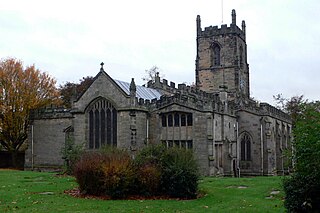
Ashby-de-la-Zouch or Ashby de la Zouch is a market town and civil parish in North West Leicestershire, England, near the Derbyshire and Staffordshire borders. Its 2001 census population of 11,410 rose to 12,370 in 2011. Ashby de la Zouch Castle was important in the 15th–17th centuries. In the 19th century the town's main industries were ribbon manufacture, coal mining, and brickmaking. From 1849 it was served by the Leicester–Burton upon Trent line of the Midland Railway.

The Ashby-de-la-Zouch Canal is a 31-mile (50 km) long canal in England which connected the mining district around Moira, just outside the town of Ashby-de-la-Zouch, with the Coventry Canal at Bedworth in Warwickshire. It was opened in 1804, and a number of tramways were constructed at its northern end, to service collieries. The canal was taken over by the Midland Railway in 1846, but remained profitable until the 1890s, after which it steadily declined. Around 9 miles (14 km) passed through the Leicestershire coal field, and was heavily affected by subsidence, with the result that this section from Moira, southwards to Snarestone, was progressively closed in 1944, 1957 and 1966, leaving 22 miles (35 km) of navigable canal.

Ashby de la Zouch Castle is a ruined fortification in the town of Ashby-de-la-Zouch, Leicestershire, England. The castle was built by William, Lord Hastings, a favourite of Edward IV, after 1473, accompanied by the creation of a 3,000-acre (1,200 ha) park. Constructed on the site of an older manor house, two large towers and various smaller buildings had been constructed by 1483, when Hastings was executed by Richard, Duke of Gloucester. The Hastings family used the castle as their seat for several generations, improving the gardens and hosting royal visitors.

The National Forest is an environmental project in central England run by The National Forest Company. From the 1990s, 200 square miles (520 km2) of north Leicestershire, south Derbyshire and southeast Staffordshire have been planted in an attempt to blend ancient woodland with newly planted areas to create a new national forest. It stretches from the western outskirts of Leicester in the east to Burton upon Trent in the west, and is planned to link the ancient forests of Needwood and Charnwood.

Donisthorpe is a village in the North West Leicestershire district of Leicestershire, England, historically an exclave of Derbyshire.

North West Leicestershire is a local government district in Leicestershire, England. The population of the Local Authority at the 2011 census was 93,348. Its main towns are Ashby-de-la-Zouch and Coalville.

Willesley is a place near Ashby-de-la-Zouch. It was in Derbyshire but is now part of Leicestershire. In the 19th century it had a population of about 60 and Willesley Hall was the home of the Abney and later the Abney-Hastings family. Willesley is so small that it would be a hamlet except that it has a church.

Loughborough is a constituency in Leicestershire represented in the House of Commons of the UK Parliament since 2019 by Jane Hunt, a Conservative. From 2010 until 2019, it was represented by Nicky Morgan who served under the governments of David Cameron, Theresa May and Boris Johnson. In 2020, she was elevated to the Peerage and became a member of the House of Lords. The constituency is a considered a bellwether, as it has reflected the national result at every general election since February 1974.
Ashby de la Zouch Rural District was a rural district in England, near Ashby de la Zouch. It was formed in 1894 along with most other rural districts. In 1974 it was abolished under the Local Government Act 1972, to form the non-metropolitan district of North West Leicestershire.
The North West Leicestershire District Council was created in 1973 and elections take place every four years. Traditionally a Labour controlled council, it was under no overall control from 1976 to 1979 and again from 1983 to 1991. In 2007, the Conservatives gained the council in a landslide for the first time since its creation.

Ivanhoe College is a coeducational middle school located in Ashby-de-la-Zouch, Leicestershire, England.
Ferdinando Hastings, 6th Earl of Huntingdon, was the son of Henry Hastings, 5th Earl of Huntingdon, and Lady Elizabeth Stanley, the daughter of Ferdinando Stanley, 5th Earl of Derby, and Alice Spencer. He married Lucy, daughter of Sir John Davies, on 7 August 1623.

Ashby de la Zouch railway station is a former railway station at Ashby de la Zouch in Leicestershire on the Leicester to Burton upon Trent Line. The Midland Railway opened it in 1849 and British Railways closed it in 1964.
Henry Isaac Stevens FRIBA was an architect based in Derby. He was born in London, in 1806, and died in 1873. In the late 1850s he changed his name to Isaac Henry Stevens.

St Helen's Church is the Anglican parish church of Ashby-de-la-Zouch, in the deanery of North West Leicestershire and the Diocese of Leicester. There was a church in the town in the 11th century, but the core of the present building mainly dates from work started in 1474, when the church was rebuilt by William Hastings at the same time that he converted his neighbouring manor house into a castle. The church was refurbished in about 1670 to create more space, but the large and increasing size of the congregation led to further work in 1829, and a major rebuild in 1878–80, including the widening of the nave by the addition of two outer aisles.

Holy Trinity, Ashby-de-la-Zouch, is a parish church in the Church of England Diocese of Leicester in Ashby-de-la-Zouch, Leicestershire.
The Ashby-de-la-Zouch Museum is a museum in the Leicestershire town of Ashby-de-la-Zouch. The primary aim of the museum is to educate the public about the history of the town. The museum also has a number of temporary exhibitions. The museum opened its doors in 1982, with the museum relocating to its present location on North Street in Ashby-de-la-Zouch. The museum is run by a group of approximately 70 volunteers.












